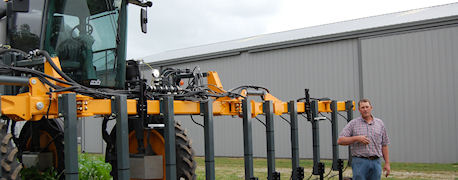
Jason Webster has a challenge for growers – shake up your nitrogen program.
The Central Illinois Practical Farm Research director for Beck's Hybrids wants to get growers out of the mindset of one-shot N applications. At a field demonstration on Brad Dorsey's farm in Bethalto, Webster stressed the importance of moving a portion of the nitrogen program to a post-emergence application.
For most, post-emergence means traditional sidedress when corn plants are just a few inches tall. Webster has been using high-clearance spray rigs for several years to extend that sidedress season.
"With a high-clearance rig, you have a much wider window to get your nitrogen on the crop," Webster says.
To date, he's experimented with dry urea broadcast over the canopy, liquid 32% N dribbled between the rows and liquid 32% N placed in row with a high pressure injection system. Webster prefers the pinpoint placement of the high pressure injection setup.
Since it requires a timely rain and has a tendency to burn leaf tissue, Webster says broadcast urea is his least preferred source of late-season N.
Finding the right rate
Splitting applications is just one of his challenges to growers. His second push is for growers to experiment with different rates until they find the one that fits their farm.
As part of Beck's Hybrids nitrogen challenge, Webster is taking his entourage of interns and high-clearance applicators to various farms across the state. The team will apply three different late-season N rates to fields – the normal rate, 50 lbs/acre more and 50 lbs/acre less.
"At the end of the season, you'll know if you over applied, under applied or had the rate just right," Webster explains.
Even if growers didn't sign up for the challenge, he urges them to try the same methodology on their farm.
"Used to be, you could over apply nitrogen because it was cheap," he adds. "You can't afford to do that today."
New add-ons
As always, Webster continues to tweak the late-season N application process. Last year, he experimented with the Y-Drop, a product that diverted liquid 32% N between the rows to ensure each stream landed closer to plant roots.
This year, Webster has loaded the high-pressure injection rig with Ag Leader's OptRx crop sensing technology. According to Ag Leader's Matt Wolfe, the crop sensing technology uses near infrared and red-edge light waves to instantly assess crop health.
The toolbar then automatically adjust the N rate according to the OptRx reading. Webster notes in healthy areas of the field, OptRx was prescribing 20 gallons of 32% N per acre.
"When we hit a yellow spot, it would bump it up to 40 gallons per acre," he notes.
Along with OptRx, Webster added a contraption to better seal the injected 32% N. The two-coulter set-up, from Nitrogen Sealing Systems, follows behind the smooth injection coulter.
It kicks up dirt, which settles overtop the injection crevice. Webster says that little bit of dirt helps seal the 32% in, further reducing the chance for volatilization.
About the Author(s)
You May Also Like




